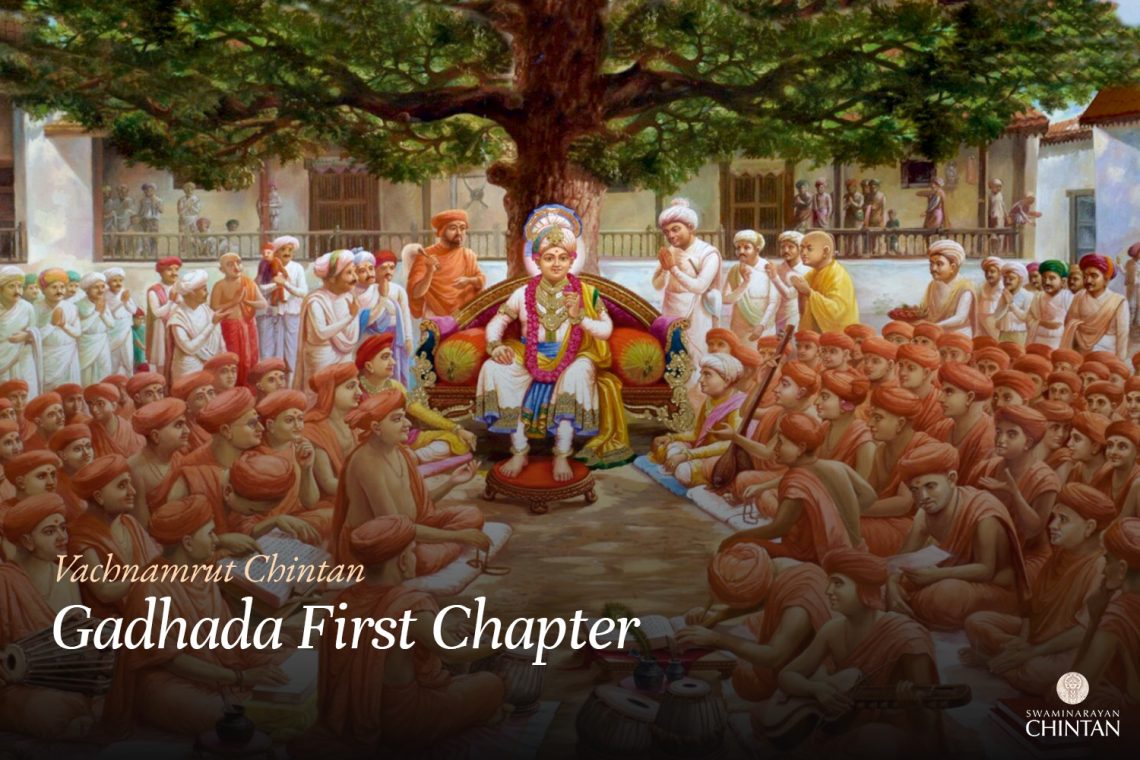Central Insights:
- Five sense objects of a devotee, and of a non-devotee
Key Points:
- A devotee, non-devotee, or even a liberated soul (Mukta) cannot live without indulging in the five sense objects.
- A safe place of refuge is necessary for seeking rest.
- It is essential to learn the technique of performing Bhajan (devotional singing) continuously and seamlessly.
Explanation
Every embodied being cannot subsist without the influence of the five sensory objects. Whether one is a devotee, a non-devotee, or a liberated soul (mukta), they cannot remain unaffected by these sensory stimuli. However, there’s a distinction in their indulgence. This Vachanāmrut categorizes the sensory indulgences into two: those related to God for the devotee and worldly ones for the non-devotee.
But then, should we recognize the sensory objects from the devotee or the devotee from their choice of sensory indulgences? A straightforward answer would be that a devotee’s actions shouldn’t dictate our understanding of sensory objects, but rather the sensory objects should determine our understanding of the devotee. Only if it’s related to God can it be considered a devotee’s object of indulgence. However, often when someone gains repute as a devotee or a saint, whatever they indulge in starts being considered a devotee’s rightful sensory object. Such societal beliefs, though widespread, aren’t accurate. It’s the sensory objects that dictate the true nature of a devotee. The essence of devotion is marked by the sensory objects they choose.
Consider the old method of drawing water using a bullock-driven wheel. The person driving the bullock was also called ‘Kosiyo’ (wheel-turner), but come lunchtime, while the bullock might eat its fodder, the ‘Kosiyo’ wouldn’t indulge in the same, due to his firm belief in his distinct identity from the bullock. Similarly, a devotee must differentiate themselves from worldly sensory objects. Anything unrelated to God should be avoided.
Now, what exactly means “related to God”? Is offering something before an idol and consuming it considered a devotion? If modern actors perform in a televised series based on religious epics like Ramayana or Mahabharata, is that to be considered divine? If women narrate religious tales, does that become a divine sensory object for men?
The real question is, would Shriji Maharaj consider these as being related to God? Because today’s so-called devotees might say they do. Anything done with faith, upholding ethics and scriptures, devoid of excess, can be offered to God. But is that enough? Do the consequences of such indulgence lead to a remembrance of the Almighty?
For instance, someone might use everything in the name of God, but those things might have been obtained unethically. On the other hand, someone might use only ethically obtained items but might cook or act in ways that are unbecoming of a devotee. How do we label such actions?
True devotion is marked by the kind of sensory objects one chooses to indulge in. Such choices should always lead to an increased remembrance of God. Therefore, a devotee needs to thoroughly reflect upon each sensory indulgence and its true nature in relation to God.
Another key point in the Vachanāmrut is about understanding the strategy to meditate upon God’s form. This strategy is about recognizing and balancing one’s inherent qualities.
After recognizing these qualities, align them with appropriate acts of devotion. For instance, during times dominated by ‘Tamas’ quality, one can engage in physical acts of devotion like prostrations, circumambulations, temple maintenance, or even simple acts like making bread or setting up incense sticks. During ‘Rajas’ dominated times, one can sing hymns, read scriptures, or involve in thought-based devotion like envisioning divine narratives. And during ‘Sattva’ dominant times, one can meditate or merely gaze upon the divine form.
References:
(1) Relevant Vachanāmruts: First Chapter. 30, 32, 58; Sarangpur 9.
(2) Bhāgavat: Skandh-3. The Virāt form, etc.
(3) Words of Gopālānand Swami: Pr. 1 – 26. Pg. 168.
(4) From Yogasūtra’s Samādhi section: 39. Through Prānāyām.
Glossary
| Bhajan – Devotion |
| Kosiyo – Wheel-turner A metaphor for distinguishing oneself from worldly sensory indulgence. |
| Mukta – Liberated soul A soul that has transcended Maya and attained eternal service of Bhagwan. |
| Murti – Divine form of God Refers to Bhagwan’s physical or imagined divine form, which provides joy and spiritual connection during contemplation. |
| Panch-Vishays – Five sensory pleasures The objects of the five senses: sound, touch, form, taste, and smell, which cause attachment and delusion. |
| Pranayam – Breath Control A yogic practice to regulate and control the breath for spiritual elevation. |
| Rajas – Passion, activity, and attachment One of the three gunas, associated with desire, action, and worldly attachments. It clouds the mind, leading to distractions and hindrances in spiritual progress. |
| Sattva – Purity, goodness, and harmony One of the three gunas (attributes) in nature, characterized by purity, knowledge, and tranquility. It is the quality of mind that leads to spiritual wisdom and devotion. |
| Tamas – Quality of Inertia and Darkness |
| Yogasutra – Text on Meditation A collection of aphorisms by Maharshi Patanjali, guiding spiritual practice. |
| Prakruti-Purush – Material Nature and Soul |
| Satsang – Holy Fellowship |
| Transcendental State – Beyond Material Influence |

